It takes a lot of faith and trust to let something—or someone—change before your eyes. It takes a lot to stand by and watch the process happen, even if you know the final outcome. You can observe, be ready to assist, and offer positive thoughts and well wishes, but ultimately the changing process is up to that person or thing. Some things are just out of your hands.
Take for example Vietnamese Caramel Sauce, or Nuoc Mau. This is a simple syrup made from sugar and water that requires a few seconds of stirring and then fifteen minutes of mindful watching.
What? No stirring? No touching? No manipulation of outcome? Gasp!
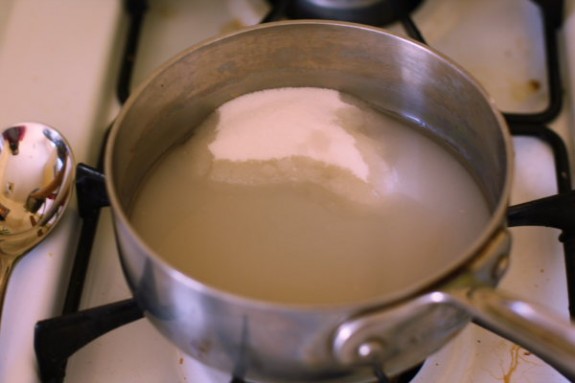
It took several failures to learn my lesson in resisting the urge to control the sauce. I had no idea how hard it would be for me to stare at a bubbling pot of hot sugar without manipulating it. I mean, one stir of a spoon and you can ruin the whole thing. An entire batch, ruined because of the need to control the cooking process of sugar and water?
Making Nuoc Mau opened my eyes to just how far my control issues go.
I don’t know about you, but I come from a family of people who like to fix things. We were brought up learning about the importance of helping out, and showing up for loved ones. If a family member is in trouble, all of us in the family like to brain storm, lend a hand, give ideas, and help make things happen. My family is made up of a bunch of creative problem solvers with no lack of ideas of how to help.
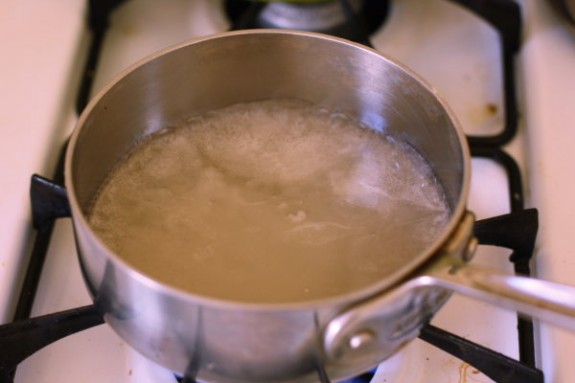
But some times you just have to stand back and observe. Just as there’s no controlling a cooking process, there’s no controlling another person’s life path. My instinctual helper gene works for me–I am doing good things at my restaurant job as a Service Guru–but sometimes this helper instinct backfires.
Which is why making one jar of a Vietnamese Caramel Sauce took me three tries to get right. But once I succeeded in making a jar of the nearly-burned sugar syrup, I experienced a culinary exercise in patience and faith in outcomes. Sometimes I just have to get out of the way and let things be.
According to Mai Pham, the respected chef and owner of Lemon Grass Restaurant and cookbook author, the two most popular condiments in Vietnamese cooking is fish sauce and a jar of home made caramel sauce. Caramel sauce (nuoc mau, pronounced “nook mao”) is a simple syrup that requires three simple ingredients—sugar, water, and restraint.
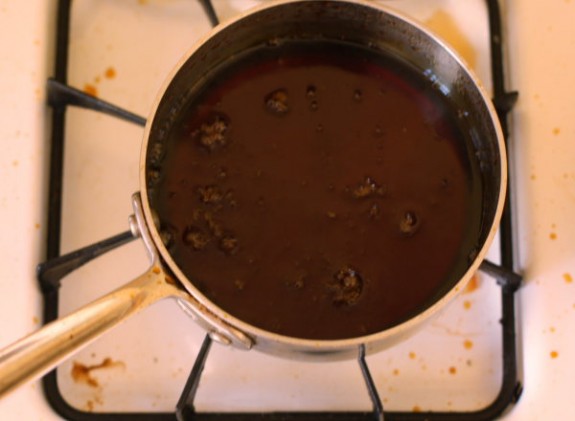
Caramel sauce (Nuoc Mau)The sauce can be used as a marinade or as a glaze for grilled meat. Don’t make the mistake of putting this sauce on ice cream or dessert, its too bitter for most sweets. From a modified version of Andrea Nguyen’s ratios from Into the Vietnamese Kitchen: Treasured Foodways, Modern Flavors
1 cup sugar
¼ cup plus ½ cup water
Combine sugar and 1/4 cup of the water into a light colored saucepan (you need to be able to monitor the color of your sauce). Stir with a metal spoon to incorporate the two ingredients. DO NOT STIR for the rest of the process. Note: If you need to move the sauce around in the pan SWIRL it*. Turn on the heat and bring the mixture to a boil. Meanwhile, heat up the remaining water in separate sauce pan.
As the sugar melts, the liquid will go from opaque to clear. Take note of the sides of the saucepan. If you see grains of sugar sticking to the side, use a pastry brush dipped in water to brush down the sides. Be careful not to let the brush fall into the cooking liquid.
Watch as tiny bubbles form at the edge of the pan and grow larger. After several minutes, frothy big bubbles cover the entire surface of the syrup. RESIST the urge to touch the saucepan! The sugar mixture will begin change from clear to golden. The change will happen quickly as the mixture will darken from golden, to brown, to dark like molasses. The moment the sauce begins to smoke, turn off the heat and slowly swirl the pot to cool it down. Watch the mixture: it will turn darker by the second. A reddish cast will set in (think the color of red wine) and the bubbles will become a burnt orange.
Here’s the dangerous part. Add the other 1/2 cup of water. Stand back and watch as this causes a dramatic bubble-and-spit reaction as the sugar syrup rapidly cools. After at least ten minutes pour the sauce into a glass jar (one with a lid) and let cool. Store in your cupboard or refrigerato.
*Swirling will cause some syrup to creep up the sides of the pan. To avoid sugar crystals to form, take a pastry brush damp with water and use it to brush the syrup back down into the pan.

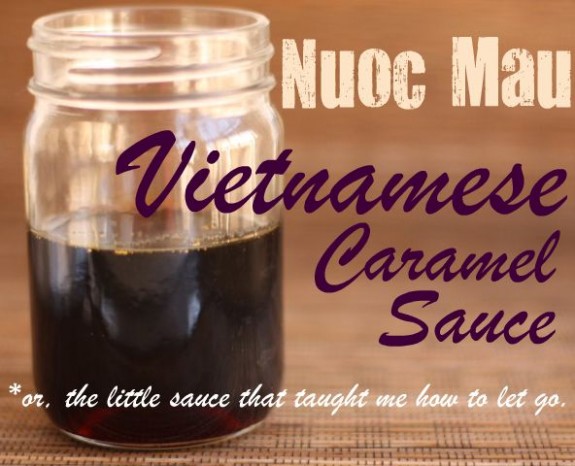
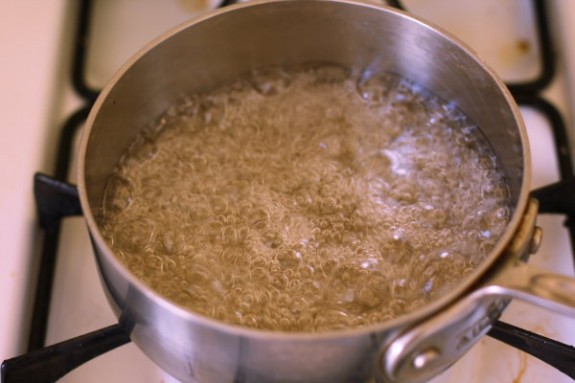

I’ve always had problems using restraint when making caramel sauce too! Once I went ahead and stirred and it turned grainy and then separated. I poured it out and tried again only to discover that you really aren’t supposed to stir! 🙂
What a great analogy. Now whenever I make caramel I’ll think of you and how at times I need to step back, let go, and let the process happen.
I’m hit or miss when it comes to caramel sauce…I’ve been wanting to make the Vietnamese style for a while. Can’t wait to see how you used it!
This is the sauce for me! It perfectly suits my tendency to just leave things alone and let them work things out for themselves. Laziness, I think they call it in other contexts.
For a character-building recipe, I need just the opposite — something with highly detailed instructions that you have to follow to the letter, paying constant attention. Maybe Marcella Hazan’s risotto, that you have to stir continuously, counterclockwise, with a 14-inch wooden spoon.
Nice post, Brooke!
My first instinct would be to stir & my second would be to dump this all over ice cream. Love control, this would be a very hard lesson in restraint as you say. This sauce must be wonderful as a grill sauce. Thanks for sharing some Vietnamese culture with us! xo
Smiled wryly when I read this post Brooke. Def’ly one that’s resonating with me right now! Will think of your sweet sauce as I try and let go 🙂 Sonnda
Ahhhh! Thank you for your clear instructions. I’ve tried 2x from different recipes and both of them didn’t say anything about not stirring so they didn’t turn out right. I’m excited to try it again!
PS, I watched a YouTube video on how to make the sauce, which really helped. Sometimes seeing how to do something once really helps!
My first attempts at making this were a disaster, until I found this recipe and I nailed it immediately and refuse to attempt any other proportions of sugar and water. I continued to make it on my crappy rental home electric burner anytime the jar ran out. However, upon upgrading to a new rental home with a gas range, I found myself screwing it up FOUR times until I realized I was letting it come to a boil too quickly. Once I turned it down a bit down I was successful again. I don’t know if anyone will run into this problem, but thought it would be worth mentioning. And thanks foodwoolf!
Sauce is kinda thick and tasty. Do I need to thin it out for use in the Mekong cocktail?